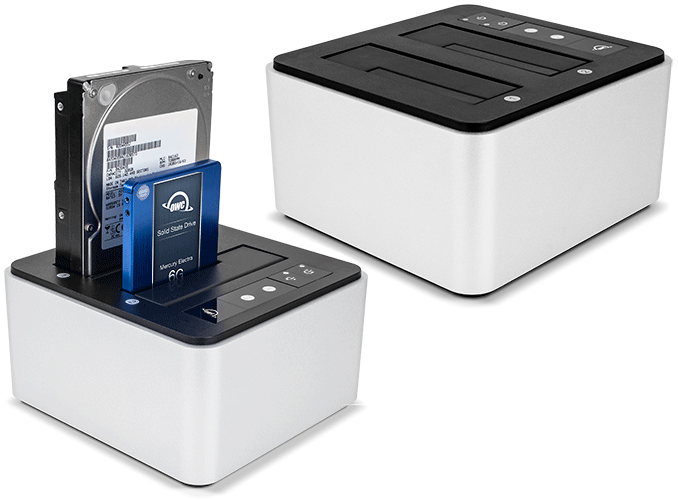OWC Launches Drive Dock with USB Type-C: Two SATA Drives, Up to 981 MB/s
by Anton Shilov on December 10, 2018 9:00 AM EST
OWC has released its new Drive Dock external storage solution that can accommodate two hot-plug-capable HDDs or SSDs. What makes this latest drive dock particularly notable is that it uses a USB Type-C interface, so it can be used with the latest laptops.
OWC’s Drive Dock (OWCTCDRVDCK) with a USB 3.1 Type-C Gen 2 interface can house two 2.5 or 3.5-inch SATA drives, supporting both HDDs and SSDs. The dock also supports RAID stripe or RAID mirror modes for extra performance or redundancy. Under the hood, the device uses Via Labs' VL820 USB 3.1 Gen 2 controller as well as ASMedia’s ASM1151 USB to SATA bridge, with OWC presumably layering software RAID on top of that.
Keeping in mind that the maximum performance a USB 3.1 Gen 2 interface can provide is just shy of 1GB/sec, it makes sense to run two SATA HDDs in RAID 0, though two high-performance SATA SSDs will likely be bottlenecked by the interface.
When it comes to compatibility, OWC’s dual drive bay solution should work with all standard SATA HDDs and SSDs. Capacity wise, this means that it can accommodate two 14 TB HDDs providing up to 28 TB of storage space and over 500 MB/s throughput in RAID 0. Alternatively, two SSDs can be used for a combination of maximum performance, or mixing & matching an SSD and HDD.
Also of note in terms of features, the Dual Drive Dock has an internal power supply; so while it does require external power (via an AC cable), it doesn't require plugging in a bulky external transformer to power the device. The internal power supply also means that OWC has been able to add some frills by allowing each drive bay to be individually powered on and of. All told, the OWC ships the Drive Dock with a USB 3.1 Gen 1 A-to-C cable, a USB 3.1 Gen 2 C-to-C cable, and a power cable.
Being rather simplistic, the OWC Drive Dock for two storage device with a USB 3.1 Gen 2 Type-C interface is also a pretty affordable at $119. If populated with two 8 TB HDDs (around $220 these days), the whole storage solution will cost about $560, which is cheaper than Western Digital’s 16 TB MyBook Duo, which retails for $599 and offers throughput of up to 360 MB/s.
Related Reading:
- OWC Ships ThunderBlade External SSDs, Touts SoftRAID Tech for 3800 MB/s Speeds
- OWC and SoftRAID create ThunderBay 4 RAID 5 Edition
- Western Digital Launches New My Book Duo Storage Systems: 360 MB/s, USB-C, 20 TB
- LaCie Announces 2big Dock: 2-Bay TB3 DAS with Card Reader, USB-A and DisplayPort
- Sharkoon Launches Quickstore One USB 3.1 Gen 2 Type-C Storage Device DIY Kit
- Pioneer’s APS-XS02 USB-C 3.1 Gen 2 External SSDs Now Available
- G-Technology G-DRIVE slim SSD USB-C 500GB External SSD Capsule Review
Source: OWC











15 Comments
View All Comments
PeachNCream - Monday, December 10, 2018 - link
Setting up RAID 0 implies the drives will remain in-place on a long term basis. Perhaps for modern 2.5 inch SSDs that would be okay, but mechanical drives continue to feature an exposed PCB on the bottom of the drive. I would be reluctant to operate a dock that doesn't entirely shelter the drives as an external storage solution. For technical support needs or one-off data transfers though, a dock like this would be an excellent solution.alacard - Monday, December 10, 2018 - link
I've used these types of docks for years and have never had a problem with them. I do add a fan to each one though to keep them cool, and that's probably overkill, but I hate heat on my tech.http://www.tritorch.com/balancez/file%20server.png
I wouldn't worry about it IMO.
The Chill Blueberry - Monday, December 10, 2018 - link
Haha, love ur drive naming!alacard - Monday, December 10, 2018 - link
Thanks, i had a lot of fun naming them.foobaz - Monday, December 10, 2018 - link
You could really use a NAS. If you RAID disks together you'll have redundancy, better speed, and you won't have to move files around to balance free space because it will be one large storage pool. If you run a COW filesystem you can take snapshots to prevent against accidental deletion. Maybe something like a Node 304 with 6x hard drives running FreeNAS.alacard - Monday, December 10, 2018 - link
I'll definitely check into a NAS RAID format. When I first started adding hard drives I never imagined it would become such a big project, but the pictures and home videos (and everything else that came with them) kept coming and I didn't know how to scale at that time. Thanks for the advice!CharonPDX - Monday, December 10, 2018 - link
I use a similar dual-drive "toaster" dock, but I use it in software RAID-1 mode as my backup target. Once a week, I swap out a drive (3-drive rotation) and rebuild the array. The swapped out drive goes to a fireproof safe. So if my house burns down, I have a backup that is at most one week old.Rocket321 - Monday, December 10, 2018 - link
Unfortunately, fireproof does not equal heat proof. If your fire safe is exposed to a structure fire your drives' electronics are likely to melt.PeachNCream - Tuesday, December 11, 2018 - link
No matter what, there will always be a scenario where data loss can happen. Backups mitigate, but don't eliminate risk. A fireproof safe is a mitigation, not a 100% sure bet. It is an improvement over leaving a drive laying around in a kitchen or dresser drawer.a351must2 - Thursday, December 13, 2018 - link
If it's not off site, it's not backed up